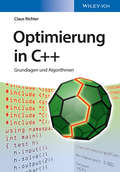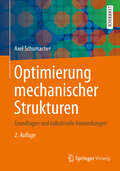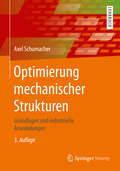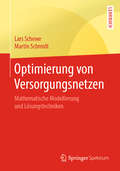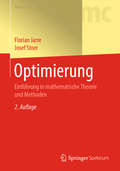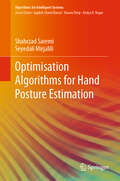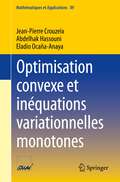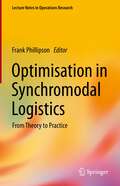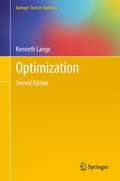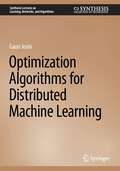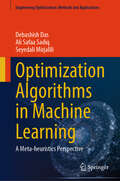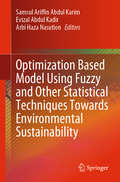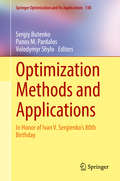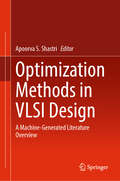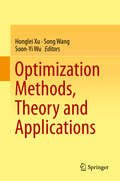- Table View
- List View
Optimale und adaptive Regelung technischer Systeme: Mathematische Grundlagen, praktisch relevante Beispiele und numerische Simulationen mit MATLAB®
by Anton BraunDieses Buch verschafft dem interessierten Leser an Hochschulen und Universitäten eine ideale Einführung in das anspruchsvolle Gebiet der optimalen Steuerung und Regelung dynamischer Systeme. Darüber hinaus werden dem Studierenden in einem separaten Kapitel die modernen Methoden der adaptiven Regelung technischer Prozesse nahegebracht, die vor allem für künftige Anwendungen von zentraler Bedeutung sind. Im Interesse eines möglichst bequemen Einstiegs in die zweifellos komplexe Materie bietet das Buch einen erschöpfenden Abriss der notwendigen mathematischen Grundlagen sowie zum Verständnis der diversen Kapitel eine Fülle praktisch relevanter Beispiele, untermauert mit den Methoden der aktuellen digitalen Simulationstechnik.
Optimality Conditions in Convex Optimization: A Finite-Dimensional View
by Joydeep Dutta Anulekha DharaOptimality Conditions in Convex Optimization explores an important and central issue in the field of convex optimization: optimality conditions. It brings together the most important and recent results in this area that have been scattered in the literature-notably in the area of convex analysis-essential in developing many of the important results
Optimierung in C++: Grundlagen und Algorithmen
by Claus RichterDie Optimierung ist einer der bedeutendsten Zweige der Mathematik mit weitreichenden Anwendungen in der Statistik, Physik, Meteorologie bis hin zur Wirtschaft und Unternehmensforschung. Ziel der Optimierung ist eine Minimierung oder Maximierung der im jeweiligen System relevanten Parameter unter einschrankenden Nebenbedingungen. Praxisbezogen fuhrt Claus Richter in die Algorithmen der Optimierung ein. Einsteiger und Fortgeschrittene werden gleicherma?en auf den heutigen Stand der Dinge gebracht. In klaren Schritten umrei?t der Autor die Grundlagen dieses Gebietes, beginnend mit Definitionen und Optimalitatsbedingungen, um sich dann direkt an den C++-Programmierer zu wenden. Der notige mathematische Apparat, die verwendete Programmiersprache C++ und ihre Klassen werden vorgestellt. Damit stellt der Autor ein einheitliches Niveau her und wird so einer breiten Leserschaft gerecht. Im Folgenden werden 20 Verfahren der linearen, quadratischen und nichtlinearen Optimierung behandelt und dem Anwender nahergebracht. Jeder Algorithmus wird im Aufbau erlautert und an einem konkreten Beispiel demonstriert. Funf weitere Kapitel widmen sich anwendungsbezogenen Sachverhalten, u.a. der Parameteridentifikation, optimalen Steuerung und Strukturoptimierung. Durch die Bereitstellung der diskutierten Algorithmen und Beispiele als C++-Klassen gewahrleistet das Buch einen optimalen Einstieg in die Optimierung.
Optimierung mechanischer Strukturen
by Axel SchumacherZiel des Buches ist es, die notwendigen Kenntnisse für den effizienten Einsatz von mathematischen Optimierungsverfahren in der Strukturauslegung von Bauteilen zu vermitteln. Der Autor bezieht die neuesten Entwicklungen und Anwendungsbereiche auf dem Gebiet der Optimierung ein.
Optimierung mechanischer Strukturen: Grundlagen und industrielle Anwendungen
by Axel SchumacherZiel des Buches ist es, die notwendigen Kenntnisse für den effizienten Einsatz von mathematischen Optimierungsverfahren in der Strukturauslegung von Bauteilen zu vermitteln. Der Autor bezieht die neuesten Entwicklungen und Anwendungsbereiche auf dem Gebiet der Optimierung ein.
Optimierung von Versorgungsnetzen: Mathematische Modellierung und Lösungstechniken
by Lars Schewe Martin SchmidtWie funktioniert der deutsche Strommarkt? Wie bestimmt man die kostengünstigsten aber ausreichend großen Rohre für Wassernetze? Wie entscheidet man, ob bestimmte Mengen Erdgas durch ein Gasnetz transportiert werden können oder nicht? Dieses einführende Lehrbuch zeigt anhand konkreter Fragestellungen aus Strom-, Wasser-, Gas- und Verkehrsnetzen, mit welchen Begriffen und Techniken sich Transportvorgänge in solchen Versorgungsnetzen durch mathematische Modelle beschreiben lassen. Neben den technisch-physikalischen Modellen lernt der Leser Techniken zur Analyse typischer Märkte und Handelsmechanismen im Energiesektor kennen. Für beide Fälle werden die mathematischen Lösungsverfahren ausführlich diskutiert. Dazu werden unter anderem klassische Flusstheorie, Optimalitätsbedingungen, lineare Komplementaritätsprobleme und gemischt-ganzzahlige nichtlineare Optimierungsprobleme behandelt, so dass der Leser automatisch zentrale Tücken ganzzahliger und nichtlinearer Optimierungsprobleme kennenlernt und sich im Umgang mit diesen übt. Das Buch beinhaltet über 50 Übungsaufgaben sowie 5 Projektaufgaben, bei denen konkrete praktische Fragestellungen am Rechner gelöst werden sollen. Vorausgesetzt werden lediglich Vorkenntnisse aus den üblichen Grundvorlesungen der kontinuierlichen und linearen Optimierung (inklusive Dualität). Das Buch ist gut als Grundlage für eine Lehrveranstaltung im Umfang von 4 Semesterwochenstunden plus Übungen im Umfang von etwa 2 Semesterwochenstunden geeignet.
Optimierung: Einführung in mathematische Theorie und Methoden (Masterclass)
by Florian Jarre Josef StoerDieses Buch führt in die Theorie und Methoden der stetigen Optimierung ein und zeigt darüber hinaus einige Anwendungen aus der diskreten Optimierung: Als gängige Verfahren für lineare Programme werden die Simplex- und Innere-Punkte-Methode vorgestellt. Im Bereich der nichtrestringierten Optimierung werden neben deterministischen Abstiegsverfahren und Trust-Region-Verfahren auch stochastische Abstiegsverfahren analysiert, die etwa beim maschinellen Lernen zum Einsatz kommen. Nach einer detaillierten Betrachtung der Optimalitätsbedingungen für nichtlineare Optimierungsprobleme mit Nebenbedingungen folgt eine Analyse von Verfahren der erweiterten Lagrangefunktion und ADMM sowie von SQP-Verfahren. Der Hauptteil schließt mit einer Betrachtung von semidefiniten Programmen und deren Anwendungen. Für die zweite Auflage wurden zahlreiche Passagen überarbeitet und mehrere neue Abschnitte zu aktuellen Verfahren und Anwendungen ergänzt. Das Buch basiert auf einer zweisemestrigen Lehrveranstaltung der Autoren und enthält zahlreiche Übungsaufgaben. Es richtet sich an Leser, die Grundkenntnisse in Analysis, linearer Algebra und numerischer Mathematik mitbringen.
Optimisation Algorithms for Hand Posture Estimation (Algorithms for Intelligent Systems)
by Seyedali Mirjalili Shahrzad SaremiThis book reviews the literature on hand posture estimation using generative methods, identifying the current gaps, such as sensitivity to hand shapes, sensitivity to a good initial posture, difficult hand posture recovery in cases of loss in tracking, and lack of addressing multiple objectives to maximize accuracy and minimize computational cost. To fill these gaps, it proposes a new 3D hand model that combines the best features of the current 3D hand models in the literature. It also discusses the development of a hand shape optimization technique. To find the global optimum for the single-objective problem formulated, it improves and applies particle swarm optimization (PSO), one of the most highly regarded optimization algorithms and one that is used successfully in both science and industry. After formulating the problem, multi-objective particle swarm optimization (MOPSO) is employed to estimate the Pareto optimal front as the solution for this bi-objective problem. The book also demonstrates the effectiveness of the improved PSO in hand posture recovery in cases of tracking loss. Lastly, the book examines the formulation of hand posture estimation as a bi-objective problem for the first time.The case studies included feature 50 hand postures extracted from five standard datasets, and were used to benchmark the proposed 3D hand model, hand shape optimization, and hand posture recovery.
Optimisation convexe et inéquations variationnelles monotones (Mathématiques et Applications #89)
by Jean-Pierre Crouzeix Abdelhak Hassouni Eladio Ocaña-AnayaDe nombreux systèmes physiques, mécaniques, financiers et économiques peuvent être décrits par des modèles mathématiques qui visent à optimiser des fonctions, trouver des équilibres et effectuer des arbitrages. Souvent, la convexité des ensembles et des fonctions ainsi que les conditions de monotonie sur les systèmes d'inéquations qui régissent ces systèmes se présentent naturellement dans les modèles. C'est dans cet esprit que nous avons conçu ce livre en mettant l'accent sur une approche géométrique qui privilégie l'intuition par rapport à une approche plus analytique. Les démonstrations des résultats classiques ont été revues dans cette optique et simplifiées. De nombreux exemples d'applications sont étudiés et des exercices sont proposés.Ce livre s'adresse aux étudiants en master de mathématiques appliquées, ainsi qu'aux doctorants, chercheurs et ingénieurs souhaitant comprendre les fondements de l'analyse convexe et de la théorie des inéquations variationnelles monotones.
Optimisation in Synchromodal Logistics: From Theory to Practice (Lecture Notes in Operations Research)
by Frank PhillipsonThis book introduces the advances in synchromodal logistics and provides a framework to classify various optimisation problems in this field. It explores the application of this framework to solve a broad range of problems, such as problems with and without a central decision-maker, problems with and without full information, deterministic problems, problems coping with uncertainty, optimisation of a full network design problem. It covers theoretical constructs, such as discrete optimisation, robust optimisation, optimisation under uncertainty, multi-objective optimisation and agent based equilibrium models. Moreover, practical elaborated use cases are presented to deepen understanding. The book gives both researchers and practitioners a good overview of the field of synchromodal optimisation problems and offers the reader practical methods for modelling and problem-solving.
Optimised Projections for the Ab Initio Simulation of Large and Strongly Correlated Systems
by David D. O'ReganDensity functional theory (DFT) has become the standard workhorse for quantum mechanical simulations as it offers a good compromise between accuracy and computational cost. However, there are many important systems for which DFT performs very poorly, most notably strongly-correlated materials, resulting in a significant recent growth in interest in 'beyond DFT' methods. The widely used DFT+U technique, in particular, involves the addition of explicit Coulomb repulsion terms to reproduce the physics of spatially-localised electronic subspaces. The magnitude of these corrective terms, measured by the famous Hubbard U parameter, has received much attention but less so for the projections used to delineate these subspaces. The dependence on the choice of these projections is studied in detail here and a method to overcome this ambiguity in DFT+U, by self-consistently determining the projections, is introduced. The author shows how nonorthogonal representations for electronic states may be used to construct these projections and, furthermore, how DFT+U may be implemented with a linearly increasing cost with respect to system size. The use of nonorthogonal functions in the context of electronic structure calculations is extensively discussed and clarified, with new interpretations and results, and, on this topic, this work may serve as a reference for future workers in the field.
Optimization
by Kenneth LangeFinite-dimensional optimization problems occur throughout the mathematical sciences. The majority of these problems cannot be solved analytically. This introduction to optimization attempts to strike a balance between presentation of mathematical theory and development of numerical algorithms. Building on students' skills in calculus and linear algebra, the text provides a rigorous exposition without undue abstraction. Its stress on statistical applications will be especially appealing to graduate students of statistics and biostatistics. The intended audience also includes students in applied mathematics, computational biology, computer science, economics, and physics who want to see rigorous mathematics combined with real applications. In this second edition the emphasis remains on finite-dimensional optimization. New material has been added on the MM algorithm, block descent and ascent, and the calculus of variations. Convex calculus is now treated in much greater depth. Advanced topics such as the Fenchel conjugate, subdifferentials, duality, feasibility, alternating projections, projected gradient methods, exact penalty methods, and Bregman iteration will equip students with the essentials for understanding modern data mining techniques in high dimensions.
Optimization Algorithms for Distributed Machine Learning (Synthesis Lectures on Learning, Networks, and Algorithms)
by Gauri JoshiThis book discusses state-of-the-art stochastic optimization algorithms for distributed machine learning and analyzes their convergence speed. The book first introduces stochastic gradient descent (SGD) and its distributed version, synchronous SGD, where the task of computing gradients is divided across several worker nodes. The author discusses several algorithms that improve the scalability and communication efficiency of synchronous SGD, such as asynchronous SGD, local-update SGD, quantized and sparsified SGD, and decentralized SGD. For each of these algorithms, the book analyzes its error versus iterations convergence, and the runtime spent per iteration. The author shows that each of these strategies to reduce communication or synchronization delays encounters a fundamental trade-off between error and runtime.
Optimization Algorithms for Networks and Graphs
by James EvansA revised and expanded advanced-undergraduate/graduate text (first ed., 1978) about optimization algorithms for problems that can be formulated on graphs and networks. This edition provides many new applications and algorithms while maintaining the classic foundations on which contemporary algorithm
Optimization Algorithms in Machine Learning: A Meta-heuristics Perspective (Engineering Optimization: Methods and Applications)
by Seyedali Mirjalili Debashish Das Ali Safaa SadiqThis book explores the development of several new learning algorithms that utilize recent optimization techniques and meta-heuristics. It addresses well-known models such as particle swarm optimization, genetic algorithm, ant colony optimization, evolutionary strategy, population-based incremental learning, and grey wolf optimizer for training neural networks. Additionally, the book examines the challenges associated with these processes in detail. This volume will serve as a valuable reference for individuals in both academia and industry.
Optimization Approaches for Solving String Selection Problems
by Panos M. Pardalos Elisa Pappalardo Giovanni StracquadanioOptimization Approaches for Solving String Selection Problems provides an overview of optimization methods for a wide class of genomics-related problems in relation to the string selection problems. This class of problems addresses the recognition of similar characteristics or differences within biological sequences. Specifically, this book considers a large class of problems, ranging from the closest string and substring problems, to the farthest string and substring problems, to the far from most string problem. Each problem includes a detailed description, highlighting both biological and mathematical features and presents state-of-the-art approaches. This Brief provides a quick introduction of optimization methods for string selection problems for young scientists and a detailed description of the mathematical and computational methods developed for experts in the field of optimization who want to deepen their understanding of the string selection problems. Researchers, practitioners and graduate students in the field of Computer Science, Operation Research, Mathematics, Computational Biology and Biomedicine will find this book useful.
Optimization Based Model Using Fuzzy and Other Statistical Techniques Towards Environmental Sustainability
by Samsul Ariffin Abdul Karim Evizal Abdul Kadir Arbi Haza NasutionThis book explores key examples concerning the implementation of information technology and mathematical modeling to solve issues concerning environmental sustainability. The examples include using fuzzy weighted multivariate regression to predict the water quality index at Perak River in Malaysia; using wireless sensor networks (WSNs) for a remote river water pollution monitoring system; deriving biomass activated carbon from oil palm shell; and assessing the performance of a PV/T air solar collector. The book offers a valuable resource for all graduate students and researchers who are working in this rapidly growing area.
Optimization Essentials: Theory, Tools, and Applications (International Series in Operations Research & Management Science #353)
by Faiz HamidThis book explores recent developments and exciting challenges in operations research and mathematical optimization. It provides the following in a unified and carefully developed presentation: (a) novel problems that have arisen in the real-life optimization domain, highlighting the challenges in each problem; (b) significant methodological advances for solving existing optimization problems, with a special emphasis on large scale problems. The book assumes a decent understanding of matrix algebra, linear and integer programming, non-linear programming, computational complexity, and graph theory. Each chapter in this book starts with an introduction to the underlying optimization technique. It then explores a real-life case study to which the technique will be applied. The objective is to demonstrate how the underlying technique can be utilized to solve a challenging problem. The chapters offer details on how to formulate a research problem into a formal optimization model, reformulate or transform it (if required) to improve computational tractability, and apply necessary customizations to the optimization technique specific to the underlying problem to derive an optimal or near-optimal solution. The book covers various state-of-the-art methods (both exact and heuristics) and modelling approaches in sync with the current research trends, which are still not discussed in typical graduate-level textbooks. Applications covered in the book span the realms of resource planning, telecommunications, scheduling, logistics, education, environmental conservation, and many others. It is thus a valuable resource for post-graduate students of operations research and mathematical optimization. It also serves as a valuable reference for researchers who wish to explore various optimization techniques as part of their research methodologies. The learning from the book should enable the professionals to apply optimization theory and algorithms to their particular field of interest.
Optimization Methods
by Marco CavazzutiThis book is about optimization techniques and is subdivided into two parts. In the first part a wide overview on optimization theory is presented. Optimization is presented as being composed of five topics, namely: design of experiment, response surface modeling, deterministic optimization, stochastic optimization, and robust engineering design. Each chapter, after presenting the main techniques for each part, draws application oriented conclusions including didactic examples. In the second part some applications are presented to guide the reader through the process of setting up a few optimization exercises, analyzing critically the choices which are made step by step, and showing how the different topics that constitute the optimization theory can be used jointly in an optimization process. The applications which are presented are mainly in the field of thermodynamics and fluid dynamics due to the author's background.
Optimization Methods and Applications: In Honor Of Ivan V. Sergienko's 80th Birthday (Springer Optimization And Its Applications #130)
by Panos M. Pardalos Sergiy Butenko Volodymyr ShyloResearchers and practitioners in computer science, optimization, operations research and mathematics will find this book useful as it illustrates optimization models and solution methods in discrete, non-differentiable, stochastic, and nonlinear optimization. Contributions from experts in optimization are showcased in this book showcase a broad range of applications and topics detailed in this volume, including pattern and image recognition, computer vision, robust network design, and process control in nonlinear distributed systems. This book is dedicated to the 80th birthday of Ivan V. Sergienko, who is a member of the National Academy of Sciences (NAS) of Ukraine and the director of the V.M. Glushkov Institute of Cybernetics. His work has had a significant impact on several theoretical and applied aspects of discrete optimization, computational mathematics, systems analysis and mathematical modeling.
Optimization Methods for Finite Element Analysis and Design (Advances in Metaheuristics)
by Ravipudi Venkata Rao Ishaan R. Kale Sujin BureeratOptimization Methods for Finite Element Analysis and Design describes recent developments in Finite Element Methods (FEM). It gives a brief introduction of the applications of AI-based nature-inspired metaheuristic algorithms and machine learning (ML) at various stages of FEM. The book covers a range of state-of-the-art application areas including medical equipment, structural analysis and machinery products.It explores the applications of optimization and ML techniques in mesh smoothing, quality improvement and Laplacian and Taubin smoothing. The book also discusses the optimization of cable nets and steel frames using nature-inspired metaheuristic methods.
Optimization Methods for Gas and Power Markets: Theory and Cases (Applied Quantitative Finance)
by Stefano Fiorenzani Enrico Edoli Tiziano VargioluAs power and gas markets are becoming more and more mature and globally competitive, the importance of reaching maximum potential economic efficiency is fundamental in all the sectors of the value chain, from investments selection to asset optimization, trading and sales. Optimization techniques can be used in many different fields of the energy industry, in order to reduce production and financial costs, increase sales revenues and mitigate all kinds of risks potentially affecting the economic margin. For this reason the industry has now focused its attention on the general concept of optimization and to the different techniques (mainly mathematical techniques) to reach it.Optimization Methods for Gas and Power Markets presents both theoretical elements and practical examples for solving energy optimization issues in gas and power markets. Starting with the theoretical framework and the basic business and economics of power and gas optimization, it quickly moves on to review the mathematical optimization problems inherent to the industry, and their solutions – all supported with examples from the energy sector. Coverage ranges from very long-term (and capital intensive) optimization problems such as investment valuation/diversification to asset (gas and power) optimization/hedging problems, and pure trading decisions.This book first presents the readers with various examples of optimization problems arising in power and gas markets, then deals with general optimization problems and describes the mathematical tools useful for their solution. The remainder of the book is dedicated to presenting a number of key business cases which apply the proposed techniques to concrete market problems. Topics include static asset optimization, real option evaluation, dynamic optimization of structured products like swing, virtual storage or virtual power plant contracts and optimal trading in intra-day power markets. As the book progresses, so too does the level of mathematical complexity, providing readers with an appreciation of the growing sophistication of even common problems in current market practice.Optimization Methods for Gas and Power Markets provides a valuable quantitative guide to the technicalities of optimization methodologies in gas and power markets; it is essential reading for practitioners in the energy industry and financial sector who work in trading, quantitative analysis and energy risk modeling.
Optimization Methods in Manufacturing Processes: A Machine-Generated Literature Overview
by Anand J. KulkarniThis book presents the result of an innovative challenge, to create a systematic literature overview driven by machine-generated content. Questions and related keywords were prepared for the machine to query, discover, collate and structure by Artificial Intelligence (AI) clustering. The AI-based approach seemed especially suitable to provide an innovative perspective as the topics are indeed both complex, interdisciplinary and multidisciplinary, for example, climate, planetary and evolution sciences. Springer Nature has published much on these topics in its journals over the years, so the challenge was for the machine to identify the most relevant content and present it in a structured way that the reader would find useful. The automatically generated literature summaries in this book are intended as a springboard to further discoverability. They are particularly useful to readers with limited time, looking to learn more about the subject quickly and especially if they are new to the topics. Springer Nature seeks to support anyone who needs a fast and effective start in their content discovery journey, from the undergraduate student exploring interdisciplinary content to Master- or PhD-thesis developing research questions, to the practitioner seeking support materials, this book can serve as an inspiration, to name a few examples. It is important to us as a publisher to make the advances in technology easily accessible to our authors and find new ways of AI-based author services that allow human-machine interaction to generate readable, usable, collated, research content.
Optimization Methods in VLSI Design: A Machine-Generated Literature Overview
by Apoorva S. ShastriThis book presents the result of an innovative challenge, to create a systematic literature overview driven by machine-generated content. This machine-generated volume, with chapter introductions by the human expert, of summaries of the existing studies furthers our understanding of the optimization methods in VLSI design. This book reviews several algorithms and methods used for solving optimization problems in VLSI Design. It introduces optimization methods in VLSI Design using meta-heuristic algorithms and how they can be applied to problems like Physical Design, Floor Planning, etc. It provides a review of High-level Synthesis techniques such as measuring the quiescent current from the power supply, crosstalk noise mitigation methodology, and geometric programming for gate-sizing to reduce the design time of a VLSI Circuit. The book delves into Power Grid Synthesis, Efficient Testing and Verification Methods, Optimization Approaches for Clocking, and Delay Minimization. This book is written for researchers, professionals, and students working in the core areas of electronics and their applications, especially in digital VLSI design and systems. Questions and related keywords were prepared for the machine to query, discover, collate and structure by Artificial Intelligence (AI) clustering. The AI-based approach seemed especially suitable to provide an innovative perspective as the topics are indeed both complex, interdisciplinary and multidisciplinary. Springer Nature has published much on these topics in its journals over the years, so the challenge was for the machine to identify the most relevant content and present it in a structured way that the reader would find useful. The automatically generated literature summaries in this book are intended as a springboard to further discoverability. They are particularly useful to readers with limited time, looking to learn more about the subject quickly and especially if they are new to the topics. Springer Nature seeks to support anyone who needs a fast and effective start in their content discovery journey, from the undergraduate student exploring interdisciplinary content to Master- or PhD-thesis developing research questions, to the practitioner seeking support materials, this book can serve as an inspiration, to name a few examples. It is important to us as a publisher to make advances in technology easily accessible to our authors and find new ways of AI-based author services that allow human-machine interaction to generate readable, usable, collated, research content.
Optimization Methods, Theory and Applications
by Honglei Xu Song Wang Soon-Yi WuThis book presents the latest research findings and state-of-the-art solutions on optimization techniques and provides new research direction and developments. Both the theoretical and practical aspects of the book will be much beneficial to experts and students in optimization and operation research community. It selects high quality papers from The International Conference on Optimization: Techniques and Applications (ICOTA2013). The conference is an official conference series of POP (The Pacific Optimization Research Activity Group; there are over 500 active members). These state-of-the-art works in this book authored by recognized experts will make contributions to the development of optimization with its applications.


